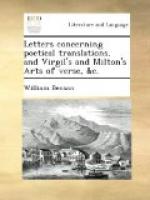“In nova fert animus mutatas
discere formas.
Ovid.
“Bella per AEmathios plus
quam Civilia Campos.
Lucan.
But a modern Writer, and a much better Composer of Latin Verses than either Ovid or Lucan, has with great Judgment taken care to follow Virgil’s Example in this and many other Particulars. I mean Vanerius. There are a great Number of Lines in his Praedium Rusticum which are worthy of Virgil himself: I shall entertain you with some of them.
In his Kitchen-Garden, the following Passage is a Description of all the numerous Family of Colworts, or the Cabbage-kind.
“Quid dicam quanta jactat se Brassica laude? Sive volubilibus redit in se frondibus, Orbesque Orbibus agglomerans, capitis sub mole laborat; Tornato similes Ebori seu candida Flores Ediderit, seu Coniacas imitata Cupressus, Seque suas plicat in frondes, & acumen in album Desinit, & tenui venit haud ingloria Mensae. Sive hieme in media cum caetera frigore torpent Loeta viret, Boreamque trucem, Caurosque malignos Despiciens, vacuis ultro Dominatur in hortis.”
In his Description of the Farm-yard, he paints the following several Sorts of Fowls in this Manner:
“Se pictae cervicis Anas | _& Garulus_ Anser Tarda mole movent: | habitu Gallina modesto Progreditur: | Caudam Gallus Cristasque rubentes Erigit, | & motis sibi plaudit Laetior alis.”
And I cannot omit this most charming Verse which describes the Courtship of a Pigeon.
“Saepe solum verrens Penna pendente rotatur.”
“Oft with his trailing Wing the
wanton Dove
Brushes the Ground, and wheels about his
Love.
Such Verse as this must please in all Ages, and in all Countries, where the Readers have any Taste and Delicacy of Ear. All the Beauties of Virgil’s Poetry are in these Lines; and you may observe in the four last mentioned,
1. How curiously the Pause is varied.
In the first Line it is upon the first Syllable of the fourth Foot.
In the second Line it is upon the first Syllable of the third Foot.
In the third Line it is upon the first Syllable of the second Foot.
In the fourth Line it is upon the last Syllable of the first Foot.
2. Observe the initial Alliteration in the first, second and third Lines.
In the first, Anas and Anser.
In the second, Mole, Movent, and Modesto.
In the third, Caudam, Cristasque.
The mixt Alliteration in the first Line where Garrulus is placed betwixt Anser and Anas, makes the Verse very sonorous; but the mixt Alliteration in the last Line where the Vowel i is repeated eight times in seven Words, is a very masterly Stroke;




